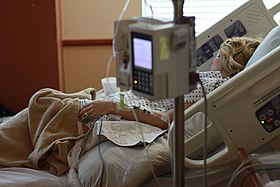
Back إدارة الألم أثناء الولادة Arabic প্রসবকালীন ব্যথা Bengali/Bangla Técnicas contra el dolor durante el parto Spanish Synnytyskipu Finnish ניהול כאב במהלך הלידה HE Doulè nan akouchman HT Ծննդաբերական ցավի կառավարում Armenian Manajemen nyeri persalinan ID Partoanalgesia Italian 無痛分娩 Japanese
| Pain management during childbirth | |
|---|---|
 Mother in labor appears to be in pain | |
| Specialty | Obstetrician |
Pain management during childbirth is the partial treatment and a way of reducing any pain that a woman may experience during labor and delivery. The amount of pain a woman feels during labor depends partly on the size and position of her baby, the size of her pelvis, her emotions, the strength of the contractions, and her outlook.[1] Tension increases pain during labor.[2] Virtually all women worry about how they will cope with the pain of labor and delivery. Childbirth is different for each woman and predicting the amount of pain experienced during birth and delivery can not be certain.[1]
Pain in childbirth also serves to protect the child and the mother during the childbirth process. Pain has some function roles to warn the body of potential danger or to the presence of injury. In the case of pregnancy, it can help the pregnant individual to detect any danger to the child, as well as adjusting to an optimal position for childbirth. In addition, Whiteburn et al. (2019) mentioned that there are also psychological functions that come with childbirth pain. As labour pain is part of a natural process, the experience is unique and hard to describe for many pregnant individuals. Many women embrace the pain as part of the process of childbirth, allowing them to better see the pain as emotional and meaningful rather than an unnecessary sensation(Whiteburn et al., 2019). "The nature of labour pain: An updated review of the literature".
Many women find that improving their environment and adopting a positive mindset towards childbirth significantly reduces the need for pain medication, contrary to the belief that natural methods benefit only a select few. Recognizing that labour pain, unlike that caused by injury or illness, is a purposeful process associated with uterine contractions underscores the effectiveness of natural pain relief techniques. Such an approach implies that with the proper support and outlook, the majority of women can manage labour pain effectively without defaulting to medical interventions. This perspective not only challenges the notion that medication is frequently necessary but also highlights the power of natural pain management strategies in creating a positive and empowering childbirth experience.
Women who have negative expectations for the process of delivery are more likely to experience increased perceptions of pain, due to the effects of nocebo hyperalgesia. These negative expectations can come from negativity in the mass media or a pre-existing distrust for the medical system.[3]
Labor pain is commonly thought to occur due to the stretching of the cervix and contraction of the uterine muscle. However, in reality, we still do not know the exact mechanism of why labor hurts, and the previous explanation is challenged by scientific explanations. For instance, the stretch receptors in the uterus disappear during pregnancy, stretch receptors in the cervix disappear at the onset of labor, and muscle fibers in the cervix are almost completely replaced by connective tissue (extracellular matrix, or ECM).
When studying uterine receptors during pregnancy and labour, it was found that the pertinent stretch receptors disappear during pregnancy, meaning that the stretching or contracting of the uterus would not be felt during that time. It was also found that stretch receptors in the cervix also disappear at the onset of labour, meaning that no sensation would be felt in that region either (Tingåker & Irestedt, 2010).[4] It is not common knowledge that sensory denervation of the uterus and cervix occurs, therefore it is a common heuristic that many people attribute the stretching sensations as the reason for pain. So, if denervation occurs, why does labour pain continue to occur? There are several reasons as to why this pain may occur, such as some of the reasons mentioned earlier on this page, however one reason that has been studied says that labour pain occurs due to vasoconstriction within the uterus. Vasoconstriction works to cause labour pain during uterine contractions. When the uterus contracts, there is a reduction in blood flow to the uterus causing hypoxia (disruption in oxygen homeostasis). This decrease in blood volume causes pain because although the uterus is denervated, the surrounding blood vessels remain innervated, and the disruption of homeostasis causes an imbalance in the system, which results in sensations of pain. Furthermore, the stronger and longer a person's contractions, the longer blood flow is reduced to the uterus, and thus the pain sensations are exacerbated (Smiley & Herman, 2006).[5]
- ^ a b "Pregnancy Labor and Birth". Office on Women's Health, U.S. Department of Health and Human Services. 1 February 2017. Retrieved 15 July 2017.
 This article incorporates text from this source, which is in the public domain.
This article incorporates text from this source, which is in the public domain.
- ^ Cite error: The named reference
Smit2012was invoked but never defined (see the help page). - ^ Carlino E, Frisaldi E, Benedetti F (June 2014). "Pain and the context". Nature Reviews. Rheumatology. 10 (6): 348–355. doi:10.1038/nrrheum.2014.17. PMID 24567065.
- ^ (Tingåker & Irestedt, 2010: https://doi.org/10.1097/aco.0b013e328337c881)
- ^ (Smiley & Herman, 2006: https://doi.org/10.1016/B978-0-323-03707-5.50074-7)